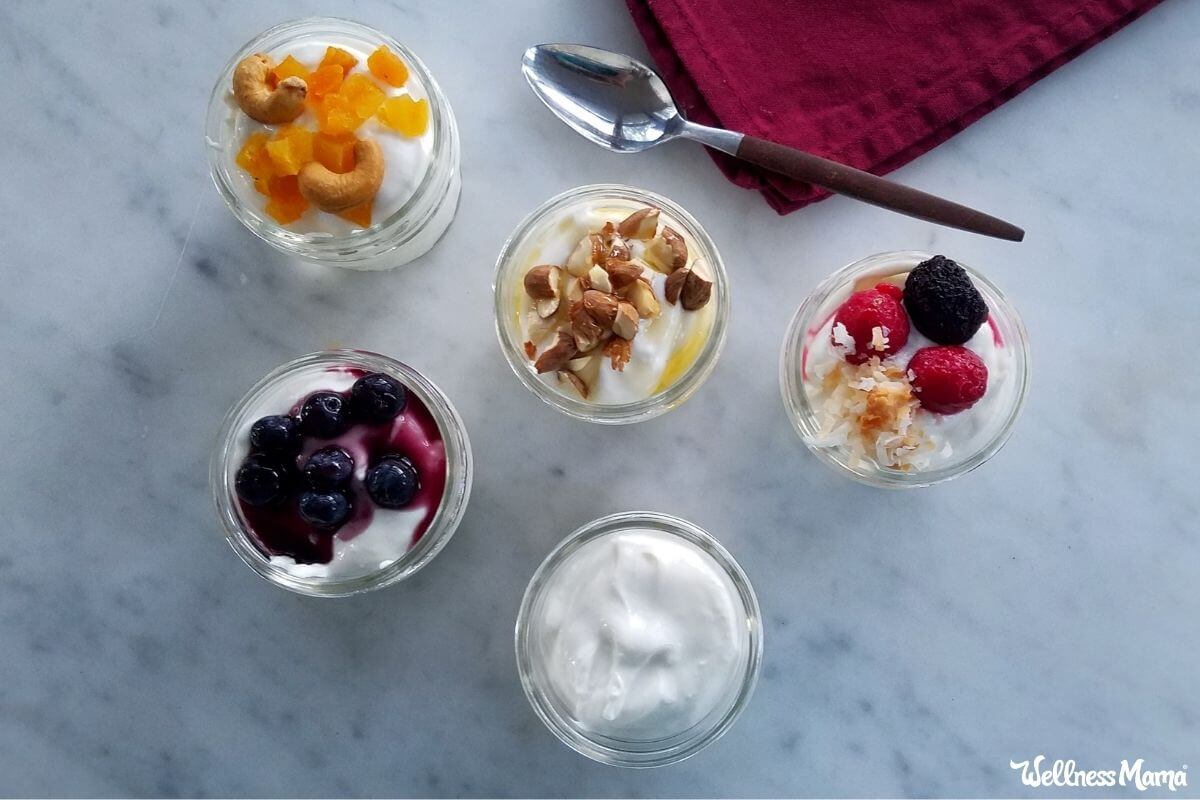Update: Since the original writing of this post, I acquired an Instant Pot with a yogurt making function. It makes yogurt-making a breeze and I can do a whole gallon at a time. For the most part, the process is the same as what’s listed below. In step three I leave the warmed milk in the Instant Pot instead of dividing it into smaller jars and in step five I put the bowl back into the Instant Pot for the incubation period.
When I started experimenting with the GAPS diet I noticed right away that eating yogurt was a big part of the diet and the process of regaining gut health.
I was super intimidated by making my own yogurt but after some initial research, I decided that it didn’t seem too hard and that I should just jump in and give it a try. I’m so glad that I did because the process was so easy and the results were wonderful.
During my research, I found that like most things, there are a million different ways to make homemade yogurt. You can order a starter or use a commercial yogurt as your starter. You can use a dehydrator, heating pad, crockpot, yogurt maker, or oven to act as your incubator.
I opted for the oven because I didn’t own a dehydrator and why get the Crock-Pot dirty when I can just throw the jars in the oven (I’m all about whatever gives me fewer dishes to wash)? I found that when I was doing the GAPS diet I was using canning jars quite a bit to store things in the fridge (bone broth, soup, sauerkraut, kimchi, etc.) so I decided that since I would more than likely be using canning jars to store my yogurt, I might as well just make it in the jars (again, less washing).
How to Make Yogurt: the Basic Process
Making your own yogurt at home is relatively easy as long as you follow these steps:
Step 1: Choosing Your Milk
First, choose your milk. This can be any kind of milk, but the more healthy your milk is the more healthy your yogurt will be. Raw milk is best, especially if following the GAPS protocol, but I didn’t have access to raw milk at the time I started making this. Instead, I used milk locally produced using a low pasteurization process that is non-homogenized, which means that I had that yummy layer of cream on top. You can also use goat’s milk.
Whatever milk you decide to use, make sure it is not ultra-pasteurized (the label of the milk will say whether it is ultra-pasteurized or homogenized). In order to get the most nutrition, I also opted for whole milk.
I typically begin by using a ½ gallon of milk. I don’t quite fill the jars all the way, so I end up using 2-quart jars and 1-pint jar.
Step 2: Heating the Milk
Put your milk in a stainless steel pan on the stove and heat over medium heat until it reaches 180°F. The first time I made my yogurt I only had a basic candy thermometer, so I had to really stay with it to watch the temperature.
More recently, I’ve purchased a digital quick read thermometer. This makes the whole process so much easier because you can set the temperature alert to 180°F and the alarm will go off when it reaches that temperature. This is also helpful later, during the incubation period.
Step 3: Cooling the milk
Once the milk reaches 180°F, pour it into the canning jars. Using a stainless steel wide-mouthed funnel made this easy to do, but just pouring from the pan or using a glass measuring cup works too.
The milk then needs to cool to 115°F. You can do this by either putting the milk in a cool water bath or just letting it sit on the counter, keeping a really good eye on it. I place the lids loosely on top of the jars to keep dirt out.
With my first batch, I used the cool water bath technique and it cooled down much sooner than I thought it would. At the time, I didn’t have a thermometer with an alarm to warn me that it had reached 115°F. Before I knew it, the yogurt was at 110°F and dropping and I flew into panic mode.
The yogurt still worked out, which just shows that it’s really hard to mess this process up and it doesn’t all have to be exact. The other thing you have to be careful of with the cool water bath is that if it’s too cool then you risk cracking the jars.
The second time I made a batch I was more patient and let it cool on its own on the countertop. It took longer but I wasn’t so stressed out from the quick temperature drop of the cool water bath.
Step 4: Adding the Culture
Once the milk has reached 115°F, you will add 2 tablespoons of pre-made yogurt to each quart of milk. The yogurt can come from either a previous batch (if you’ve already made some) or from store-bought yogurt. You can also use a store-bought yogurt culture, but using pre-made yogurt is easier and less expensive.
Personally, I use organic plain Greek yogurt for my starter. Stir lightly, just to incorporate the yogurt into the warm milk. Then, put the lids on the jars.
Step 5: Incubating the Yogurt
Once the culture has been added, it is ready to go into the oven to incubate (with the lids on). You want a fairly consistent temperature.
The first couple of times I made my yogurt I just used the 40-watt appliance light bulb that was in the oven. I found that the temperature was dropping lower than I wanted it to, so I would have to turn the oven on to heat it back up every couple of hours. I incubated it overnight and didn’t wake up to check the temperature or turn the oven on, but when I woke up in the morning the temperature was reading 100°F which is less than optimal incubation temperature (115°F would have been better).
Interestingly, it didn’t ruin my yogurt and it still came out really well. Again, it just goes to show that this method is hard to mess up (even with all of the mishaps during my first experiment). I have since (ok, my husband has) replaced our 40-watt bulb with a 60-watt bulb and it now holds the temperature closer to the optimal 115.
If the temperature goes above 115°F you run the risk of killing your culture. You may need to do some testing with your oven light to see what temperature it holds at when the light is on for a period of time and try 40-watt and 60-watt bulbs. The optimal incubation range is 95-115°F.
The yogurt needs to incubate for at least 10-12 hours. The GAPS protocol calls for a 24 hour incubation period in order for the majority of lactose to be consumed by the bacteria (this article does a great job explaining all of that). The longer it incubates, the more tangy the finished yogurt will be.
Important note: Just make sure not to forget that you are incubating yogurt in the oven and accidentally turn the oven on. My new digital quick read thermometer makes this less likely to happen. The thermometer probe goes into the oven sitting in one of the jars, while the digital display portion of it sits on top of my stove so that I can easily monitor the temperature of the yogurt. Seeing the digital display sitting on my stovetop keeps me from forgetting about the yogurt incubating in the oven and accidentally turning it on.
Once the yogurt is done incubating, refrigerate it to set the yogurt and just pour off the extra whey. The whey can be saved to use for other recipes, especially if you are following the GAPS protocol.
If you want a thicker yogurt then you can always strain off the remaining whey using cheesecloth. Personally, I’ve never been a fan of super thick yogurt so I found that I really enjoyed it just the way it was once the whey was poured off after the yogurt was refrigerated and set.
My favorite way to eat the yogurt is with local raw honey drizzled over it. It’s also really good in smoothies or added to soups.

How to Make Yogurt (Easy Homemade Recipe with or without Instant Pot)
Servings
Equipment
- 2 quart-size mason jars with lids
- Heat source such as heating pad, oven light, slow cooker, or Instant Pot.
Ingredients
- 8 cups milk (preferably raw whole milk)
- 4 TBSP yogurt starter
Instructions
Oven Light Method
- Heat the milk in a stainless steel pan on the stove over medium heat until it reaches 180°F.
- Pour heated milk into clean canning jars and cool, either by sitting on the counter or in a cool water bath until the temperature drops to 115°F.
- Use a clean whisk to mix the yogurt starter into the cooled milk.
- Place the jars into the oven with the light on for 12-24 hours. The light should provide a consistent heat of about 110°F.
- Put jars into the refrigerator until the yogurt is cold and set.
- Once the yogurt is set you can pour off the liquid whey from the top or strain the yogurt using a cheesecloth for a thicker consistency.
Instant Pot Method
- To heat the milk in the Instant Pot, press the yogurt button until the display reads boil.
- When it beeps, check that the temperature is at least 180°F.
- Cool the heated milk by either letting it sit on the counter or in a cool water bath in the sink until the temperature drops to 115°F.
- Use a clean whisk to mix the yogurt starter into the cooled milk.
- Return the inner pot to the Instant Pot and press the yogurt button until the display reads a number of hours.
- Press the "+" or "-" button until the display reads the desired length of time. I like to incubate mine for at least 12 hours. Incubating for 24 hours will yield the tangiest yogurt with the least amount of lactose left. Do not incubate for longer than 24 hours or the probiotics will start to die off from lack of food.
- Once the time is up, put the pot of yogurt into the refrigerator until the yogurt is cold and set.
- Once the yogurt is set you can pour off the liquid whey from the top or strain the yogurt using a cheesecloth for a thicker consistency.
- Enjoy!
Nutrition
Notes
Have you tried your hand at making your own yogurt? How did it turn out? What type of starter and milk did you use?




Leave a Reply